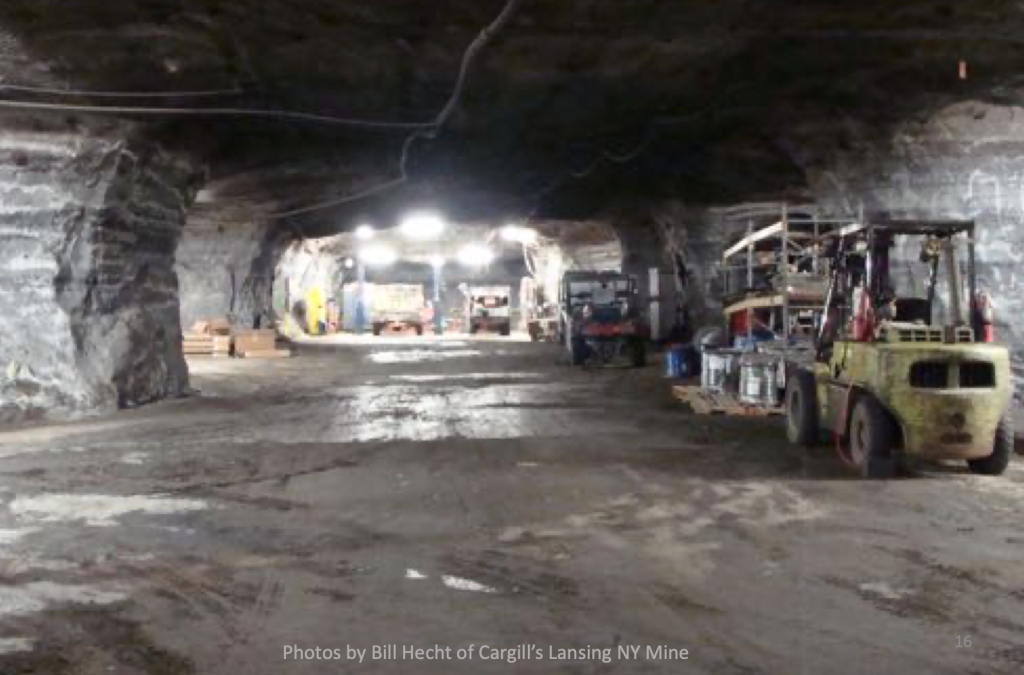LANSING, Jan. 9, 2023 — Cargill Inc. is seeking the state’s permission to add a new 150-acre underground storage area for water that has been steadily leaking into its Cayuga Lake salt mine, according to a recently disclosed application to modify its mining permit.

The state Department of Environmental Conservation is still reviewing the application, which was filed seven months ago but only made public Monday through a Freedom of Information Law request.
Before knowing about the pending application, several groups had been raising concerns recently about the mine’s potential threat to Cayuga Lake in the wake of reports that Cargill is trying to sell it.
Worried that a mine flood could spike salinity levels in the lake, they have called on Gov. Kathy Hochul to require Cargill to complete an environmental impact statement (EIS) and to post a substantial bond.


“An EIS for this mine, including a thorough, fully transparent evaluation of the risks associated with its current operations, is decades overdue,” Liz Kreitinger, executive director of the Cayuga Lake Watershed Network, said today, one day after her group sent an appeal to Hochul.
“Any significant changes in operations proposed in the recent (permit modification) application should absolutely be included in this review,” Kreitinger added.
According to application, the company wants to pump water into the mine’s deepest level in an abandoned section known as S3, which is at the mine’s extreme southern end.
Cargill says S3 could hold 360 million gallons — enough to fill roughly 750 Olympic-size swimming pools. It would provide the mine 15-18 years of storage capacity if it is filled at the expected rate of 1.3-1.8 million gallons per month.

The application doesn’t specify current leak rates at the mine or suggest that a recent increase prompted the need for additional water storage space.
“Inflow sources and rates are well understood, and water has been managed at various locations across (Cargill’s Cayuga) mine over decades,” said the application, prepared for Cargill by Johnson, Mirmiran and Thompson Inc. (JMT). “The submission of this application is made without prejudice to Cargill’s position that the update to the water storage location does not require a modification to its permit.”
In recent years, water inflows have been stored in a section of the mine’s Level 4. But that storage space has been approaching capacity, according to recent mine annual reports.
The permit modification application states that all water stored in S3 “will be sufficiently saturated to minimize dissolution of the remaining salt pillars, floor and roof.” Monthly inspections will “monitor ground conditions, check gas levels and record the advance of the shoreline.”

The introduction of brine to the S3 area will increase humidity, according to a monitoring plan that accompanies the application. Rising humidity tends to increase rates convergence in walls and roof, which can lead to subsidence (sinkholes) on the surface. “Monitoring of humidity and its effects on convergence will continue as water is stored in the S3 workings,” the application states.
Zoe Scoba, the Cargill mine engineer who signed an environmental assessment included in the modification application, did not respond to a phone message or questions sent to her email.
John Dennis, a founder of CLEAN (Cayuga Lake Environmental Action Now), declined to comment on the modification application before speaking with geological experts.
CLEAN has obtained more than 3,000 signatures on a petition calling on Gov. Hochul to require Cargill to prepare an environmental impact statement and to post a $10 billion bond.

“An independent review will shed critical light on the on-going risks of mine collapse, lake salinization, and other damage to the surrounding land,” the CLEAN petition says. “Should the review recommend the mine be permanently closed, New York State must heed that recommendation and require an environmentally sound end-of-life plan.”
The DEC provided the modification application to WaterFront late Monday in response to a Nov. 30 FOIL request.
On Dec. 8, WaterFront requested under FOIL all communications between the DEC and Cargill in connection to the modification application.
The agency said to expect a response by Jan. 9. After this article was posted, the agency produced several documents which were not in a format that WaterFront was able to access. The DEC did not immediately respond to a request that the documents be resent in a common format such as a PDF.
After this article was first posted, the DEC confirmed that it was still considering Cargill’s June 30 application for a permit modification.


A full EIS should be done and a SCOPE should precede it to ensure that all risks and possible outcomes are evaluated. The process should be made as public as possible.
LikeLike
Looks like sea bass will be returning soon to Cayuga Lake! The next I LOVE NY campaign will draw tourists and fisherman to the Fingerflakes for saltwater fishing. I have a feeling this does not get better Again, GREAT reporting Pete!
LikeLike
Peter,
Nice article! How do you know that DEC has not yet approved the application? Perhaps your Dec 8th FOIL request will shed more light on this issue.
The language “…without prejudice…”: is it your impression that Cargill has already begun storage of waters in S3 without asking DEC permission, i.e., it’s not the sort of material change that requires any amendment of the permit, but we’ll do the application if it makes you happy”?
I haven’t yet send the application to anyone, but will do so now.
Thanks for sharing it with us.
Best, John
LikeLike
In the cut line under the first photo – is the water seepage rate ” per month ” or ” per minute ” ?
LikeLike